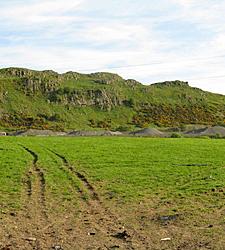
Ravelrig Bog, near Edinburgh© GUARD Archaeology Ltd
Ben Miller
Source - http://www.culture24.org.uk/history-and-heritage/archaeology/art503348-bog-material-reveals-years-of-scottish-history-at-prehistoric-hillforts-near-edinburgh
Evidence of prehistoric man and the woodland clearances of the Iron Age are found at the site of two hillforts near Edinburgh Peat from a bog near Edinburgh contains 11,500-year-old vegetation and glimpses of the impact made by humans on the landscape from as far back as the Neolithic period, say experts who have foraged seven metres into the earth across parts of a site previously known for prehistoric settlements. Ravelrig Bog, where an early Iron Age palisaded homestead was found during preparations for a quarry extension, contains two hillforts. Kaimes Hill offers evidence of human activity from the Mesolithic period, while the unexcavated Dalmahoy Hill is thought to have been occupied during the pre-Roman Iron Age and early medieval times.

The view towards Kaimes Hill from Dalmahoy Hill© Richard Webb, geograph.org.uk/photo/887660
Woodland resources for fuel and building material, found at the homestead, have been radiocarbon dated to between 400 and 800 BC.
“The bog started out as a small lochan [lake] within a rocky hollow that was formed at the end of the last glacial period,” says archaeobotanist Susan Ramsay, discussing pollen analysis on the Ravelrig core as part of a report concluding that there is “plentiful archaeological evidence” of the people who once roamed the region. “Aquatic plants gave way to marshland and finally raised Sphagnum bog as natural succession progressed.
“During the early Holocene, the woodlands of the area were dominated by birch, hazel and willow but developed into mixed oak, elm and hazel woodlands by the mid-Holocene.

Kaimes Hill© MJ Richardson, geograph.org.uk/photo/649252
“Most previous studies of the vegetation history of central Scotland have concentrated on the last 3,000 years of environmental history.
“This has tended to be because extensive industrial and agricultural activity in the central belt of Scotland, which was the industrial heartland of the country, has removed many potential sites of palaeoenvironmental importance over recent centuries, and so there have been few chances to construct a pollen diagram from this region that covers most of the Holocene period.
“The presence at Ravelrig Bog of an area of deep peat in an area that has a rich archaeological record and is also located close to agricultural land provided a unique opportunity to study the effects of human activity on the environment of this part of Scotland.”
An initial survey, in 2007, revealed the incredible scientific potential of a core deposit covering more than 10,000 years of history. “Previous studies have suggested that the first major woodland clearances in central Scotland occurred in the pre-Roman Iron Age, with the cleared agricultural landscape being maintained throughout the Roman period,” says Ramsay. “However, at Ravelrig, human impact on the landscape is recorded from the Neolithic period onwards, with increasing woodland clearance and agricultural activity in the Bronze Age and a peak in activity in the pre-Roman Iron Age.

Looking south from Long Dalmahoy Road© MJ Richardson, geograph.org.uk/photo/2393533
“Pastoral agriculture was the dominant form of farming in the area, although there is evidence for the cultivation of cereals from the later Bronze Age onwards.
“These periods of agricultural intensification appear to correspond with known periods of occupation at the nearby hillforts.”
A slight decline in agriculture between 250 BC and AD 150 could have followed the abandonment of Dalmahoy and the Roman invasion.“Birch pollen levels increased significantly, suggesting that land that was previously farmed was abandoned and was gradually colonised by birch woodland,” says Ramsay.

Exposed rock along the hillfort at Dalmahoy Hill. The unseen north side of the hill, just beside the triangulation pillar, is quarried© Richard Webb, geograph.org.uk/photo/887647
The birches gave rise to the oak and elm trees which later colonised the woods. A slight increase in activity, between AD 400 and 600, could show that the hill fort was set for reoccupation during the early medieval period, although the subsequent 850 years saw alder and birch growth take over, chiming with evidence from other sites in central Scotland at the time. “It is not clear what the cause of this agricultural decline might be but further work may be able to determine a more precise date range for this event,” believes Ramsay. “It has been suggested that there were some reversions to a colder and wetter climate during the sixth to ninth centuries AD, which could explain why areas once suitable for agriculture perhaps became too wet to grow crops and agriculture had to be moved to sites with better drainage.

Dalmahoy Hill, looking south from Long Dalmahoy Road© MJ Richardson, geograph.org.uk/photo/2393533
“This explanation could account for the significant increase in alder – a tree of wetter areas and river banks that is seen at Ravelrig during this period.
“The last major episode of woodland clearance began around AD 1450, with the cleared landscape continuing until the present day.”
The full results of the research, funded by Tarmac Ltd have been published at archaeologyreportsonline. com.